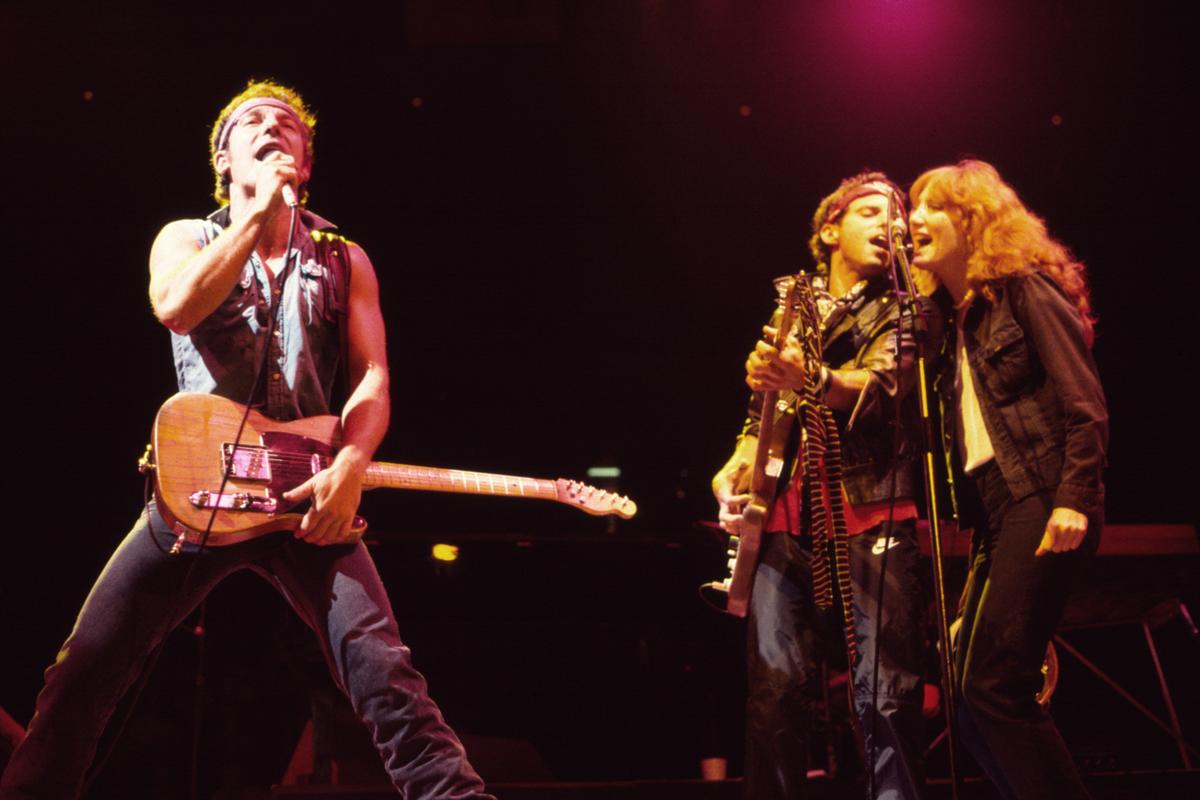For nearly the entirety of his career as a performing and touring musician, Bruce Springsteen had had an issue with taking his show to bigger venues. His reluctance was well known, and he had historically been slow to make such moves, even as the number of people who wanted to see him grew.
“When we were in clubs,” he told biographer Dave Marsh for Marsh’s 1987 book Glory Days. “… we’d play five or six nights in a club before we’d go into a theater. … [W]e played five or six nights in a theater before we’d go into an arena. In the arena, we’d play five or six nights in the arena.”
When plotting the tour in support of his 1984 album Born in the U.S.A., Springsteen and his management took the same route they’d taken since 1978’s Darkness on the Edge of Town: with a long trek through North American arenas. Beginning June 29, 1984 in St. Paul, Minn., the Boss and the E Street Band played 94 indoor shows, ending in Syracuse, NY January 27, 1985.
New Faces on E Street
It was a time of change for all involved. Prior to the release of Born in the U.S.A., longtime musical partner Steven Van Zant left the group; he was replaced by former Neil Young sideman, Grin front man and solo artist Nils Lofgren on guitar and background vocals. Singer (and future Mrs. Springsteen) Patti Scialfa was also brought on board to bolster the vocal presence onstage. Springsteen’s personal life, too, was heading in a new direction – in the fall of 1984, he would meet and begin dating actress Julianne Phillips; they married the following spring.
Professionally, Springsteen had never been bigger – Born in the U.S.A. would sell 30 million albums worldwide and yield seven U.S. Top 10 singles. As the tour moved through North America, it became apparent that demand for tickets far outstripped the supply, and that subsequent legs would need to be staged in much bigger venues.
The tour breezed through Australia and Japan, before hitting its European leg, which consisted of 18 shows in massive soccer stadiums. It all nearly unraveled immediately.
The Irish Debacle
An estimate 93,000 people attended the first concert, at Ireland’s Slane Castle, including a number of inebriated fans who shoved, fought, drank, passed out and came to, right in front of a shocked and anxious Springsteen.
“Fans were pouring, red faced, soaked in booze and heat exhaustion, over the front barriers to be taken to the medical tent or to flank the crowd, throw themselves back in and take another crack at it,” Springsteen recalled in his 2016 memoir Born to Run. Audience members would fall to the muddy ground, vanishing until their friends picked them back up. “Then, once standing,” Springsteen wrote, “they’d slosh back the other way and the whole interminable, nerve-grinding exercise would be repeated again, ad infinitum.”
It was Springsteen’s worst nightmare as a performer – an out-of-control audience over which he held little (if any) sway. He was afraid someone would get really hurt, or worse – “I thought somebody was going to get killed,” he wrote, “and it’d be my fault.”
During intermission, Springsteen had a “highly charged debate” with his manager, Jon Landau, over canceling the entire European tour, rather than having to deal with crowds of such numbers, in such an unruly, dangerous state. Landau convinced Springsteen to continue playing and see how the rest of the show and the next several dates transpired. The situation settled, and the tour moved on.
The crowds at the remainder of the European shows were still lively, but not as disorderly as the Irish audience. Springsteen and band responded with energetic, high-spirited performances, gaining confidence with each date, including a raucous show in front of 80,000 in Milan and three nights at London’s Wembley Stadium.
Back to the U.S.A.
Once the European stadium leg of the tour was complete, it was time to swing back to the U.S., where nearly 1.9 million eager fans had scooped up tickets for 28 stadium concerts in 14 cities. Springsteen was ready.
“Our anthems were built to fill and communicate in places of this size,” Springsteen wrote in his memoir, “so from Timbuktu to New Jersey, crowds dropped one by one to the powerhouse show we’d started developing overseas.”
The Born in the U.S.A. tour ended with four shows at the Los Angeles Memorial Coliseum, Sept. 27, 29, and 30, and October 2, 1985, to some 83,000 attendees per night. It was a rousing and fitting end to a truly historic rock ‘n’ roll tour.
“We were now one of the biggest, if not the biggest, rock attractions in the world and to get there we hadn’t lost sight of what we were about,” Springsteen noted in Born to Run. “There were some close shaves, and in the future I’d have to be doubly vigilant about the way my music was used and interpreted, but all in all, we’d come through intact, united and ready to press on.”
Top 100 ’80s Rock Albums
UCR takes a chronological look at the 100 best rock albums of the ’80s.
Gallery Credit: UCR Staff
